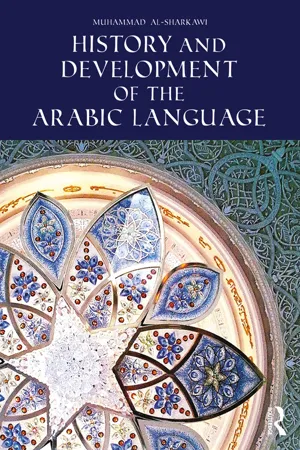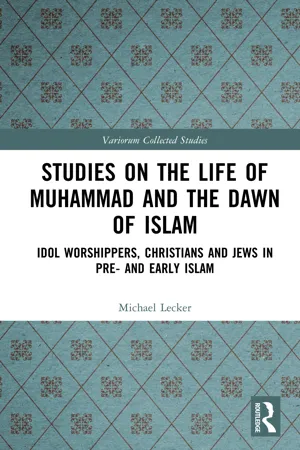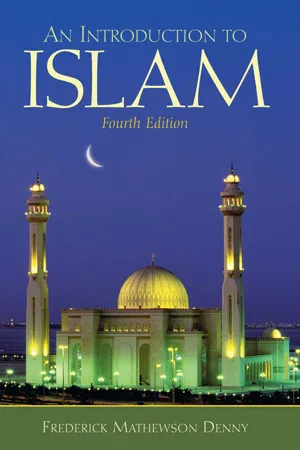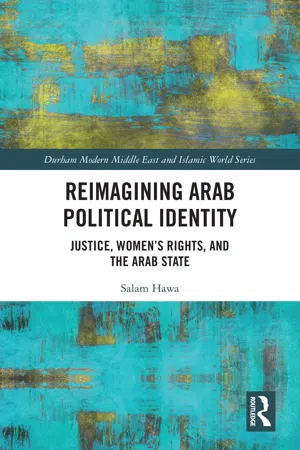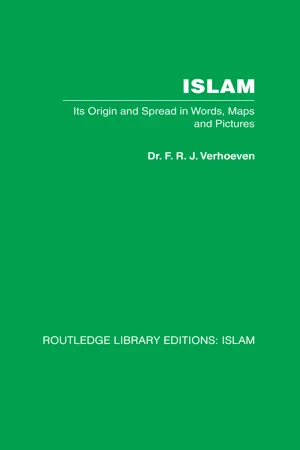History
Pre-Islamic Arabia
Pre-Islamic Arabia refers to the period before the rise of Islam in the 7th century. It was characterized by a diverse array of tribes and clans, each with their own customs, languages, and religious beliefs. Trade routes and the pilgrimage to Mecca played significant roles in the region's economy and culture.
Written by Perlego with AI-assistance
Related key terms
Related key terms
1 of 4
Related key terms
1 of 3
8 Key excerpts on "Pre-Islamic Arabia"
- eBook - ePub
- Muhammad al-Sharkawi(Author)
- 2016(Publication Date)
- Routledge(Publisher)
1 The geography and demography of Pre-Islamic Arabia This Chapter This rather short chapter is dedicated to setting the stage for understanding the ecology of the Arabian Peninsula in pre-Islamic times. Ecology is the external non-linguistic factors that help us contextualize and navigate through the blurred historical and structural boundaries among varieties and mitigate the acuity of data shortage, as the knowledge of the stars and the four main directions help a lost hiker in the wilderness (Steffensen and Fill 2014: 6). This chapter, therefore, is not a historical narrative of events. It is rather an attempt to isolate relevant aspects of Pre-Islamic Arabia to the emergence and development of Arabic and the interaction of its speakers with the speakers of other languages. Introduction This is the geographical ecology of Pre-Islamic Arabia in late antiquity and early Islam. In this rather descriptive and small chapter, we will present and discuss the home country of the pre-Islamic Arabs. I will briefly discuss the relevant geographical features of the Arabian Peninsula insofar as their influence on communication among Arabs and between Arabs and non-Arabs is concerned. The reader should not expect to read here a full topographical description of the terrain of ǧazīrat al-‘Arab, ‘the Arabian Peninsula,’ in pre-Islamic times. Our main interest is to demonstrate that there was a geographical continuity and lack of natural barriers between the different parts of the Semitic world. But before this rather small section, the chapter will introduce a description of the internal social structure of the Arab tribes as a Semitic group of people, along with their tribal affiliation and distribution among Bedouin and non-Bedouin tribes and clans in their pre-Islamic shape. I will address this issue in two sections: one will be dedicated to the designation of the Arabs (who was an Arab and who was not), while the other discusses the tribes as social institutions - eBook - ePub
Studies on the Life of Muhammad and the Dawn of Islam
Idol Worshippers, Christians and Jews in Pre- and Early Islam
- Michael Lecker(Author)
- 2023(Publication Date)
- Routledge(Publisher)
Part 1 ARABIA ON THE EVE OF ISLAMPassage contains an image
1Pre-Islamic ArabiaDOI: 10.4324/9781003374824-2C. Robinson (ed.), The New Cambridge History of Islam. I: The Formation of the Islamic World Sixth to Eleventh Centuries, Cambridge: Cambridge University Press, 2010, 153–70Tribal historiography
The literary sources in Arabic dealing with Pre-Islamic Arabia are copious but rarely give direct answers to questions which are of interest to modern research. Still, the following had to be based on these sources since Arabian archaeology is only emerging; one hopes that significant Arabian pre-Islamic sites incur no damage before they are excavated.Arabian society was tribal and included nomadic, semi-nomadic and settled populations. The settled populations had genealogies similar to those of the nomads and semi-nomads, identifying them as either “northern” or “southern” through the identity of their presumed eponyms. Not only did genealogy define the individual tribe, it also recorded its links with other tribes within families of tribes or tribal federations, each including several or many tribes. Muḥammad’s tribe, Quraysh, for example, was part of the Kināna, and hence the other tribes of the Kināna were its closest relatives. The settled populations, which probably included more people than the nomadic and the semi-nomadic populations put together, do not receive a proportionate share in the literary sources because the limelights are typically on the nomads, more precisely on their military activities, no matter how insignificant. Tribal informants focused on the military activities since the performance of town dwellers in the realms of trade and agriculture was less spectacular, and hence less contributive to tribal solidarity.After the Islamic Conquests the tribes underwent significant changes, but they preserved their genealogy and their rich oral heritage that was inseparable from the genealogy. The amount of the materials that were transmitted and preserved was naturally affected by the size and political influence of the individual tribes. It stands to reason, however, that tribes that lived in or around the main centres of intellectual endeavour, such as Baṣra and Kūfa, stood a better chance of having their heritage recorded when oral accounts became written literary history. Regarding the time of Muḥammad, the coverage of individual tribes was uneven since it was also affected by their role at that time. Tribes such as Ghifār, Muzayna, Juhayna and others roaming around Mecca and Medina (pre-Islamic Yathrib)1 - eBook - ePub
- Frederick Denny(Author)
- 2015(Publication Date)
- Routledge(Publisher)
The Arabs traditionally trace their roots back to two major sources: the northerners and the southerners. They consider the southern branch, centered in Yemen, to be the peninsula’s aboriginal peoples, whereas the northerners, who settled in Hejaz, Najd, Palmyra, and Nabataea, are thought to have become assimilated to Arabism through a kind of naturalization process. These latter are thought to have descended from Adnān, a descendant of Ishmael. The two branches of Arabs have remained distinct to this day, although Islam did much to narrow the gap between them. The southern branch also regards itself as having descended from biblical forebears: Joktan, the grandson of Shem (Gen. 10:25–26). According to the Bible, other Arabian groups, particularly in the north, sprang from the union of Abraham and his other wife, Ketura (Gen. 25:1–4).The Pre-Islamic Arabian past to which Islam looks back is not the civilized past of the Yemen but the pastoral-nomad dominated past of Hejaz, which is generally considered to have been barbarian and wild. No outside power had ever succeeded in subduing the region, owing to its remoteness, the difficulty of the terrain, and the extreme fierceness of its inhabitants, who possessed certain technical as well as systemic advantages when defending their own territories. The term al-Jāhilīya is applied to the life and times of the Arabs in Hejaz and surrounding areas during the centuries before Islam. This term means, literally, “the ignorance,” but it also includes the notion of barbarism. It is a term coined in Islamic times and is thus intended to discredit the idolatrous and licentious days of old, before the Islamic virtues and habits came to transform, to some extent, the life of the Arabs.Social Structure and Economy
Before we describe the pre-Islamic Arabs’ worldview, it is necessary to understand something of their social structure and economy, for these are intimately linked with it. The dominant pattern of life was pastoralist, with the people divided into more or less independent tribes. Although these tribes concluded alliances with one another in an ad hoc - eBook - ePub
Reimagining Arab Political Identity
Justice, Women's Rights and the Arab State
- Salam Hawa(Author)
- 2021(Publication Date)
- Routledge(Publisher)
2 History, language, identity of Pre-Islamic Arabia
DOI: 10.4324/9780429424625-2In his book, Arabic Historical Thought in the Classical Period (1994), Tarif Khalidi states that in the Qur’an pre-Islamic Arab history is characterised as jahili . This damning indictment of over 5,000 years of ancient Arab civilisation has led modern Arabs to associate their ancestors with wilful ignorance, lawlessness, and debauchery. Khalidi acknowledges that traditional historical narratives depend on an “axial text,” such as the Bible or the Qur’an, and that these texts are themselves products of certain cultures, “a particular way of viewing and representing the past.” For Khalidi, traditions are “not born” but are made up of elements that “belong to the debris of earlier traditions” (Khalidi, 1994: 1). Despite this acknowledgement, the author quickly dismisses ancient Arab culture and starts his account of Arab historical thought with the Qur’an and the first Arab Empire. Khalidi rightly points out that cultural and economic importance shifted from South Arabia to North Arabia and contrasts the economic and cultural rise of Arab cities in the north to the descent into anarchy and oblivion of “Arabia Felix ”1 in the south. As North Arab tribes developed their “own traditions in a new cultural zone,” formed “commercial and religious towns,” and their “script and dialect … dominated the Peninsula,” South Arabian civilisation became “a distant and dimly perceived memory and cherished most of all by tribes claiming southern descent” (Khalidi, 1994: 1–2).While there is no doubt this shift had taken place, and the arrival of the Qur’an provided a natural starting point for Muslim historians, this approach is nevertheless problematic on two levels: cultural and religious. First, Arab historians’ decision to overlook the role South Arabian civilisation played in shaping North Arab culture is based on the commonly held view that the two groups were ethnically distinct (Grunebaum, 1963: 5). South Arabians were the original Arabian Arabs (‘aribah ), wealthy traders who established such kingdoms as Saba’ (1200 bce–275 ce) and Himyar (110 bce–525 ce), whose dialect died out in the north during the third century and in the south by the sixth century ce (Macdonald, 2010: 5). North Arabians, on the other hand, were Arabised Arabs (musta‘ribah ) of mainly nomadic stock, who were often employed by South Arabian kings to protect the walls of their kingdoms and to engage in military expeditions (Restö, 2005: 129). The distinction between ethnicities is important, since Arab historiography, which started with the Umayyad dynasty, defined the Arabs as members of certain nomadic tribes.2 - eBook - ePub
Classical Islam
A History, 600 A.D. to 1258 A.D.
- G. E. von Grunebaum(Author)
- 2017(Publication Date)
- Routledge(Publisher)
HE devout Muslim is inclined to see the appearance and rise of his religion in the light of a miracle; the overwhelming success of the Prophet’s mission is for him the most compelling confirmation of its truth. Even the non-believer is prepared to see if not a miracle at least something miraculous in the fact that such a towering and finely developed structure should arise on a foundation as narrow from the point of view of population and civilization as pagan Central and North Arabia; a structure which derived its survival and its greatness from its ability to transform itself from a religious community possessed of a national political character into a commonwealth of culture which was both religious and supranational, while yet retaining its existence and validity as a state. The political history of Islam contains a paradox peculiar to this religion alone: it is the history of the transformation of an Arab sect into a community dominating an empire, and furthermore a universal religious community which was primarily non-political, yet was the determining factor in political events and imposed its own qualities on whole cultures. In other words it was not the physical domination but the cultural power of the new teaching, not its origin in a particular geographical and intellectual zone but its immanent universality, which proved the deciding factors in its development. In the same way the new experience of the divine which it brought with it proved more inflammatory than the sense of identification with the Arab nation which was disseminating it. Yet, a further paradox, the Arabs have until the present day always claimed and been conceded a kind of privileged position within the Islamic community.Arab pride and at times the townsman’s periodic access of romantic feeling for the desert have served to keep within bounds the tendency to despise pre-Islamic paganism and all its works which followed the conversion. Yet the animosity of the subject peoples, who could only vent it against the pre-Islamic Arabs, the Arab Muslim’s consciousness of progress, and the obvious difference of cultural level between the Syrian and Mesopotamian border lands and the peninsula have all fostered the attitude that the pagan period was one not far removed from general barbarism. This attitude is one shared by the Islamic community and by Western scholars. South Arabia, the Arabia felix - eBook - ePub
The Erasure of Arab Political Identity
Colonialism and Violence
- Salam Hawa(Author)
- 2017(Publication Date)
- Routledge(Publisher)
Since pre-Islamic times to the present day, young members of Arabian tribes are accorded the freedom to choose how they wish to live their lives (Macdonald, 2009a I), and are given the choice of cleaving to the community or striking out on their own. Whichever they choose, they are left with the understanding that they have to live with its consequences. The Arabian poets, long before the rise of Islam, reflected this ethos perfectly, and illustrated the price they had to pay for their choice of either to embrace the community and abide by its laws or become outlaws, shunned and hunted. However, to understand the reasons for their choices, we need to take a closer look at the structure of the social and political practices in Pre-Islamic Arabia.Social and political structure in Pre-Islamic Arabia
As stated above, Arabia witnessed the greatness of many kingdoms in the north and the south. The Nabataean and Palmyrene Kingdoms in the north flourished as trade centres along the route to India. Of north Arab stock, evidenced from their names, language and religion, their society was nevertheless a blend of Greek, Syriac and Parthian (Persian) elements. The Nabataean Kingdom lost its influence after its annexation by the Roman Empire in 106 ce , and Palmyra was of little consequence after its destruction by Aurelian in 272 ce .In the south, the Sabaeans, Minaeans and Himyarites were also peace-loving, trading kingdoms, known for their ingenuity in building dams and cisterns, and digging wells to irrigate their vast agricultural production. Theirs was a unique blend of old tribal system, caste stratification, feudal aristocracy and monarchy (Hitti, 1956: 58), and they were first to establish colonies in Abyssinia (today’s Ethiopia), to which many of them retired after the breaking of the Ma’rib dam. Their trade route overland went through the Fertile Crescent connecting Europe with India, which was a great source of friction between the Parthian and Roman Empires. They had several trade stations dotted along the western passage through Mecca to Syria and Egypt, and exercised complete control over all trade in the region. At their height, Petra (capital of the Nabataean Kingdom) and Palmyra were stops along the way, and shared in south Arabia’s prosperity. South Arabian kingdoms lost monopoly over trade when the Egyptians under Ptolemy II (285–46 bce - eBook - ePub
- Robin Leonard Bidwell(Author)
- 2019(Publication Date)
- Routledge(Publisher)
Pre-Islamic and Mediaeval YemenThe Yemen in the Pre-Islamic Era
As late as the l960 it was the custom of every commentator on North Yemen to state, with the air of one making a profound and original observation, that the country was still living in the Middle Ages. There was more than a grain of truth in this view, and, indeed, some of the customs of the country were even older; so it is necessary, in a way that it is not for other Arabian states whose history effectively begins with the discovery of oil, to say something about the early history of the area. Able scholars have chronicled these years in detail so it is not the intention of this author to give particulars of the fortunes of dynasties long since disappeared, but rather to give an outline which will show their relevance to the present day.There is no doubt that man was active in South-West Arabia from ancient times. We need not accept the legend that Cain was exiled to Aden (although a tomb reputed to be his was shown near the Main Pass), but archaeologists say that the area was used for hunting 75,000 years ago, and flints used 15,000 years ago have been recovered. Tradition identifies Joktan, the great-great-great-grandson of Noah, with Qahtan, who is regarded as the ancestor of the Southern Arabs and as the man who brought agriculture to the Yemen. His son, the Jerah of Genesis, was said to have separated the Arabic and Hebrew languages. Hud, whose tomb may still be seen in the Hadhramawt, was mentioned in the Holy Qur'an as the first of the Prophets of Arabia, while Job was also reputed to be a native of the Yemen.We come on to firmer ground about 1200 BC - eBook - ePub
Islam
Its Origin and Spread in Words, Maps and Pictures
- F R J Verhoeven(Author)
- 2013(Publication Date)
- Routledge(Publisher)
Little is known of the early history of this inaccessible region. The interior of the ‘Island of the Arabs’ was inhabited by nomadic Bedouin tribes, who, with their lean herds of small livestock and camels, trekked from place to place in search of food from its meagre pastures. Raids and inter-tribal warfare were common occurrences among this proud and militant people, and their valorous deeds were handed down from generation to generation in the form of heroic ballads. Although the tribes, headed by their chieftains or sheiks, enjoyed a large measure of independence, many were united for a short time in the Kingdom of Kindah, which reached the zenith of its power at the beginning of the sixth century B.C. and soon afterwards disintegrated again.Continually obstructed by a pitiless nature in their hard and difficult existence, the Bedouin worshipped trees, rocks, and spirits, or practised a primitive polytheism. Their most revered relic was the Kaaba, the oval Black Stone in Mecca, which was the spiritual centre of the land of the Arabs.Only here and there was this rugged, inhospitable region crossed by a few hesitating, difficult caravan routes. Trade, which usually chooses the shortest route, therefore did not pass through this desert region but circumnavigated it, in the east and south by sea and in the north via the Isthmus of Suez, through Palestine and Syria. The world was smaller then than now and was mainly composed of the areas bordering the Mediterranean in the west and the countries of Southern Asia in the east, with the Indies and China on the horizon. The Arabian peninsula occupied a central position between these two halves of the world, and its trade was, naturally, primarily a transit trade. Situated in the north – in the Trans-Jordanian region – lay the old town of Petra (meaning rock), a flourishing trading centre in the prosperous Nabataean kingdom, and brilliant Palmyra, dating from a few centuries later, both of which owed most of their wealth to the transit trade with the south, with Arabia Felix (Happy Arabia).
Index pages curate the most relevant extracts from our library of academic textbooks. They’ve been created using an in-house natural language model (NLM), each adding context and meaning to key research topics.
Explore more topic indexes
Explore more topic indexes
1 of 6
Explore more topic indexes
1 of 4
